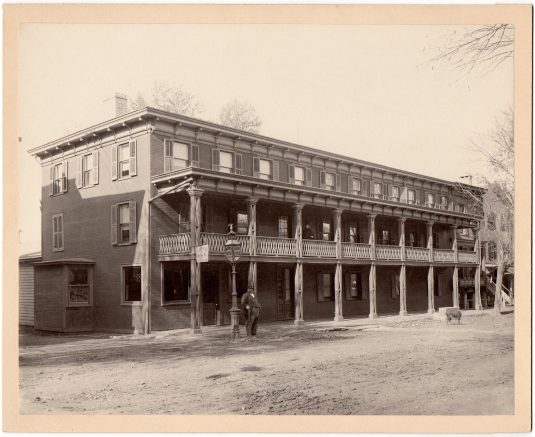
This is one of my favorite photographs.1 The building is Mount’s Hotel on Flemington’s Main Street, across from and a little north of the Union Hotel. It was replaced in the 1970s by the group of shops called ‘New Market,’ built by Don Shuman.

This is one of my favorite photographs.1 The building is Mount’s Hotel on Flemington’s Main Street, across from and a little north of the Union Hotel. It was replaced in the 1970s by the group of shops called ‘New Market,’ built by Don Shuman.
For some time, I have been writing articles about the early taverns in Hunterdon County, knowing how important they were to both travelers on Hunterdon’s earliest roads and the communities that built up around them. One of the taverns on my to-do list was Larason’s Tavern on the Old York Road north of Ringoes. Fortunately, Dave Harding, administrator of the Hunterdon County Historical Society, did the job for me. His history of the tavern appeared in the most recent issue of the Hunterdon Historical Record (vol. 59, no.1), the Historical Society’s regular newsletter.
With Dave’s permission, I am reprinting the article here along with some footnotes and additional information at the end. This has been a real treat for us both.
Part Two of my history of the Pittstown Inn ended with the death of Moore Furman in 1808. Part three will describe the Inn’s 19th century owners and its innkeepers—quite often not the same people.
I ended part one of the Pittstown Inn when the Revolution came to an end. The Treaty of Paris was finally signed on September 3, 1783, thanks to the efforts of America’s representative at the negotiations, Benjamin Franklin.
In her excellent book All Roads Lead to Pittstown (2015),1 Stephanie Stevens called attention to the early roads that converged on the village of Pittstown. Roads were certainly important, but just as important were creeks in creating the locations of Hunterdon villages.
There was a time when the sleepy little village of Quakertown was a lively place, back when it had two taverns. I learned this from Egbert T. Bush, who wrote a couple articles about the village.
This is an article by Egbert T. Bush about the village of Cherryville in Franklin Township, Hunterdon County. It serves as a follow-up to my article on the earliest owners of the Cherryville Tavern, back when the village was known as Anderson Town, after the early tavern owner, James Anderson.
This article will be followed by one written by Egbert T. Bush titled “Cherryville, Once Called Dogtown, Has Long History.” He knew the Cherryville Tavern was an old tavern, but could only get back as far as Reuben McPherson, who owned it from 1827 until his death in 1831.
This article by Egbert T. Bush describes a particular neighborhood, not far northwest of Flemington, at the intersection of today’s Thatcher’s Hill Road and Sand Hill Road.
In my research I have often come across references to Johnson’s Tavern as a landmark. Deeds refer to it when identifying roads, like “the road from Swamp Meeting House (Locktown) to Johnson’s Tavern” or “the road from Rittenhouse Tavern (Rosemont) to Johnson’s Tavern.” And sometimes it is just “the great road to Johnson’s Tavern,” which is today’s Route 519 through Kingwood Township.